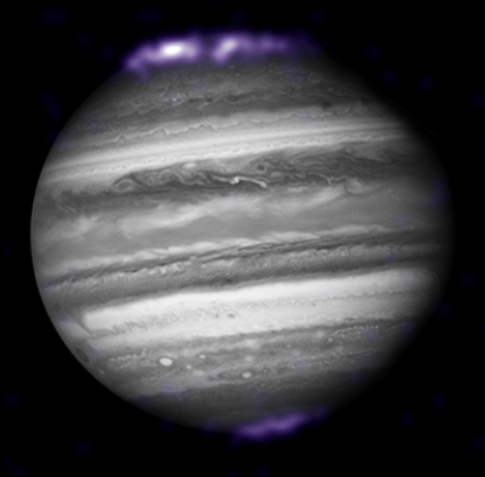
 Credit:X-ray: NASA/CXC/SwRI/R.Gladstone et al.; Optical: NASA/ESA/Hubble Heritage (AURA/STScI)
Credit:X-ray: NASA/CXC/SwRI/R.Gladstone et al.; Optical: NASA/ESA/Hubble Heritage (AURA/STScI)
Crown and Tail
The aurora borealis and aurora australis (the northern and southern lights), powered by planetary magnetic fields, are among the pre-eminent natural wonders on earth. Jupiter's magnetic field is about 10 times stronger than earth's, so imagine how spectactular the aurorae on Jupiter would appear, to those fortunate enough to be able to see them. We can count ourselves among that lucky few, thanks to cameras on powerful telescopes and high-flying spacecraft. The image above is a composite optical image of Jupiter by the Hubble Space Telescope, along with an X-ray image of the Jovian aurorae taken by the Chandra X-ray Observatory. Chandra's image shows high energy radiation generated by the interaction of atomic ions of oxygen and sulfur which interact with particles ejected from the sun in the solar wind. These oxygen and sulfur ions are believed to largely originate in eruptions of Jupiter's volcanic moon Io. This latest Chandra observation of Jupiter occurred as the New Horizons spacecraft whizzed by Jupiter on its way to its ultimate destination, Pluto and points beyond. New Horizons, the fastest spaceship ever, passed through Jupiter's "magnetic tail", a location that no other spacecraft ever probed. The Chandra X-ray measurements of the brightness of Jupiter's aurorae and local measurements in the magnetic tail by the instruments on New Horizons, give astronomers a never-before view of the complex interplay between magnetic activity, solar wind, and volcanic activity in the Jovian system.
<
HEA Dictionary ● Archive
● Search HEAPOW
● Other Languages
● HEAPOW on Facebook
● Download all Images
● Education ● HEAD
>
Each week the HEASARC
brings you new, exciting and beautiful images from X-ray and Gamma ray
astronomy. Check back each week and be sure to check out the HEAPOW archive!
Page Author: Dr. Michael F. Corcoran
Last modified Tuesday, 27-Feb-2024 10:08:19 EST


